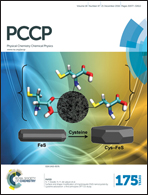Encumbrance in desilylation triggered fluorogenic detection of the fluoride ion – a kinetic approach†
Abstract
Highly selective fluorogenic detection of the fluoride ion becomes viable due to its propensity towards cleaving Si–O and Si–C bonds, the key reactive elements in fluoride selective chemodosimeters. Herein, acridinedione derived, two novel fluorescent probes bearing tertiarybutyldiphenylsilyloxy (TBDPS) and tertiarybutyldimethylsilyloxy (TBDMS) groups were synthesized and their fluoride selective dosimetric action in organic solvents and in mixed aqueous medium was established through steady state and time resolved fluorescence techniques. Unusually, these molecular probes maintain their sensitivity down to 10 ppb in both organic and mixed aqueous medium; hence they can be considered as highly selective and sensitive fluorescent probes for the fluoride anion. By following the kinetics of the desilylation process it is established that the reaction follows second order kinetics with respect to fluoride ion concentration in acetonitrile whereas it becomes first order in mixed aqueous medium owing to its high degree of hydration. Also, the hydrophobic and sterically crowded substitution on the silyl receptor hampers the reaction kinetics only in organic solvents whereas its influence in mixed aqueous medium is relatively very less. However, common inorganic cations (Na+) effectively hinder the reaction kinetics through strong ion pair interaction and prolong the response time. Therefore, the indigenous influences of three different factors which encumber the desilylation process were quantitatively enumerated and the prospective application of these fluorescent probes in detecting and validating fluoride ions in various environmental samples is demonstrated.


 Please wait while we load your content...
Please wait while we load your content...